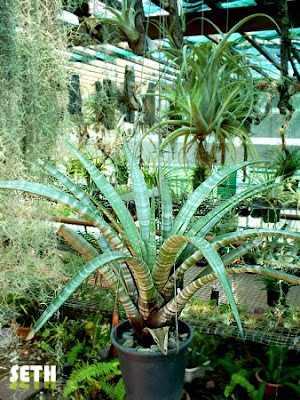Tillandsia hildae is native to Peru. It is found at an altitude of 1000 to 1200 meters above sea level.
Tillandsia hildae is a species of the genus Tillandsia. This species was described by Werner Rauh in 1973.
IDENTIFY TILLANDSIA HILDAE AIR PLANT
Tillandsia hildae is native to Peru. It is found at an altitude of 1000 to 1200 meters above sea level.
It is a very large (can exceed 2 meters in height and diameter at flowering), acaule or with a very short stem, saxicolous species that has many, large (can exceed 80 cm), rigid, green but quickly becoming purple leaves that form a rosette. Limbs in the form of an attenuated ribbon, with raised edges (in a gutter). The leaves are dark green, with beautiful scaly and white transverse bands, especially on the underside.
This air plant bloom from the very large (can approach a meter), robust inflorescence with a blackish purple axis, very branched with numerous thin, elongated ears (inflorescence bipinnate, even tripinnate). The bracts of the flowering stem are enveloping, those at the bottom of the inflorescence resemble leaves, those at the upper part of the inflorescence are oval. The primary bracts are similar to the tallest floriferous stalk bracts, not very scaly and dark purple. The floral bracts are erect, ovate, leathery, dark purple with sometimes a green border, nerves (especially when dry). The non-fragrant flowers are almost tubular, leathery, 4 to 5 cm long, purple in color. The stamens and the pistil are exserts.
TILLANDSIA HILDAE AIR PLANT CARE AND CULTURE
Cultural information should only be used as a guide, and should be to be adapted to suit you. Your physical location; where you grow your plants, how much time you have to devote to their care, and many other factors, will need to be taken into account. Only then can you decide on the cultural methods that best suit you and your plants.
Light:
Tillandsia hildae can grow in partial shade or sunny. Avoid still full sun in the afternoon summer if the plant is young or has not been used to. Place the plant very close to a window in the winter, preferably outside in partial shade in summer.
Temperature:
The required temperature ranging from 10 to 32°C. Get it early enough in the fall if you grow it outside, so that it does not face night temperatures below 8 ° C, especially if it is wet.
Humidity:
This air plant need the relatively low level of humidity. Good aeration is required, the plant must dry quickly (in less than an hour).
Substrate, growing media and repotting:
Tillandsia hildae can be grow in pot or mounted on a solid substrate that does not retain water. Growing in pots (with stones) gives very good results because the plant does not like, he seems to be moved or move. You can glue the plant directly to the surface with a strong adhesive, or you can wire the plant to the base. Don't cover the base of the plant with moss or it may rot. It can be grown on almost any imaginable decorative mount, including shells, rocks, slate, driftwood, etc.
Watering:
Everyday in summer, two or three times a week in winter according to the luminosity and the ambient humidity. Obviously when it rains and if you grow it outside, it counts as a watering. Leave water in the rosette in summer (except at the beginning of flowering, so as not to drown the inflorescence when it does not emerge from the rosette), changing it regularly (every 3 days).
Fertilizer:
This air plant quite greedy in fertilizer, do not forget to give it from time to time (once a month in winter and 3 times a month in summer).















I’m getting two of these … I’m in Texas …. Water is hard alkaline and it’s very hot in summer and very cold in winter.. any growing tips?
ReplyDeleteYou can try to grow them indoor with some light source, keep it more dry when cold and more wet when hot! Avoid position of too high humidity! Grow them in pot with stones, and good luck!
Delete